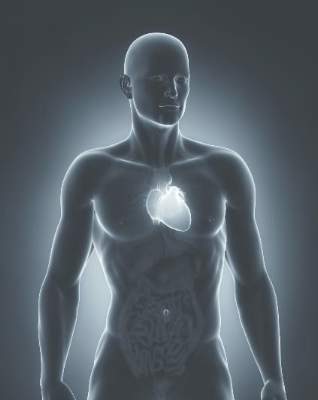User login
When combined with conventional risk factors, hemoglobin A1c modestly aids in prediction of atherosclerotic cardiovascular disease risk, according to a retrospective analysis published online Sept. 8 in Circulation: Cardiovascular Quality and Outcomes.
Conventional risk factors for CVD such as sex, age, blood pressure, smoking, or lipid level are important tools used to aid in clinical decision making. However, there is current debate about whether to include hemoglobin A1c in the algorithms, despite the clear association of CVD with glucose levels, said Jamie A. Jarmul of the University of North Carolina in Chapel Hill, and colleagues.
They used data from the 2011-2012 National Health and Nutrition Examination Survey (NHANES) to analyze CVD risk factors and HbA1c in 2,000 individuals aged 40-79 years without a history of diabetes or CVD. Utilizing a regression model, the distribution of HbA1c based on patient characteristics was predicted. The impact of the predicted HbA1c on the 10-year atherosclerotic CVD risk was calculated with the use of example clinical scenarios.
Factors considered significant predictors of HbA1c were HDL-cholesterol, total cholesterol, current smoking, sex, age, race/ethnicity, and systolic blood pressure. Further, individuals who were of black, Asian, or Hispanic race/ethnicity were associated with prediction of higher HbA1c.
The investigators noted that by using the final model, they found a modest effect of HbA1c on post-test atherosclerotic CVD risk in participants with intermediate risk. In the example clinical scenarios, an HbA1c of more than 6.5% was associated with increase in posttest atherosclerotic CVD risk by 1.0%-2.5% points. An HbA1c less than 5.7% was associated with a lowering of posttest atherosclerotic CVD risk by 0.4%-2.0% points (Circ Cardiovasc Qual Outcomes. 2015 Sep 8. doi:10.1161/CIRCOUTCOMES.115.001639). The authors note the posttest atherosclerotic CVD risk of having an elevated HbA1c (greater than 6.5%) is similar to being 5 years older.
“The results we have presented here represent a necessary intermediate step before conducting these more comprehensive analyses assessing the utility of HbA1c testing in ASCVD [atherosclerotic cardiovascular disease] primary prevention and the larger question of universal screening for abnormal blood glucose levels,” the authors noted.
The National Institutes of Health supported the study. Dr. Pignone reports being a member of the U.S. Preventive Services Task Force (USPSTF).
With the modest effects of HbA1c on risk classification combined with its low cost, wide availability, and low risk, even a small improvement in cardiovascular disease risk prediction may add value to the current models.
However, utilizing biomarkers to create personalized risk prediction models has not seemed to return great results for CVD risk reclassification. Therefore, it may be time to consider alternative methods based on expert consensus.
Furthermore, it may be reasonable to move away from markers of the disease to detection with methods such as coronary artery calcium by noncontrast CT scan to detect the presence or, perhaps just as importantly, the absence of atherosclerosis.
Dr. Khurram Nasir is director of the Center for Healthcare Advancement and Outcomes in Coral Gables, Fla. These comments are taken from an accompanying editorial (Circ Cardiovasc Qual Outcomes. 2015 Sep 8. doi:10.1161/CIRCOUTCOMES.115.002207). Dr. Nasir reported consulting for Regeneron and being on the advisory board for Quest Diagnostic.
With the modest effects of HbA1c on risk classification combined with its low cost, wide availability, and low risk, even a small improvement in cardiovascular disease risk prediction may add value to the current models.
However, utilizing biomarkers to create personalized risk prediction models has not seemed to return great results for CVD risk reclassification. Therefore, it may be time to consider alternative methods based on expert consensus.
Furthermore, it may be reasonable to move away from markers of the disease to detection with methods such as coronary artery calcium by noncontrast CT scan to detect the presence or, perhaps just as importantly, the absence of atherosclerosis.
Dr. Khurram Nasir is director of the Center for Healthcare Advancement and Outcomes in Coral Gables, Fla. These comments are taken from an accompanying editorial (Circ Cardiovasc Qual Outcomes. 2015 Sep 8. doi:10.1161/CIRCOUTCOMES.115.002207). Dr. Nasir reported consulting for Regeneron and being on the advisory board for Quest Diagnostic.
With the modest effects of HbA1c on risk classification combined with its low cost, wide availability, and low risk, even a small improvement in cardiovascular disease risk prediction may add value to the current models.
However, utilizing biomarkers to create personalized risk prediction models has not seemed to return great results for CVD risk reclassification. Therefore, it may be time to consider alternative methods based on expert consensus.
Furthermore, it may be reasonable to move away from markers of the disease to detection with methods such as coronary artery calcium by noncontrast CT scan to detect the presence or, perhaps just as importantly, the absence of atherosclerosis.
Dr. Khurram Nasir is director of the Center for Healthcare Advancement and Outcomes in Coral Gables, Fla. These comments are taken from an accompanying editorial (Circ Cardiovasc Qual Outcomes. 2015 Sep 8. doi:10.1161/CIRCOUTCOMES.115.002207). Dr. Nasir reported consulting for Regeneron and being on the advisory board for Quest Diagnostic.
When combined with conventional risk factors, hemoglobin A1c modestly aids in prediction of atherosclerotic cardiovascular disease risk, according to a retrospective analysis published online Sept. 8 in Circulation: Cardiovascular Quality and Outcomes.
Conventional risk factors for CVD such as sex, age, blood pressure, smoking, or lipid level are important tools used to aid in clinical decision making. However, there is current debate about whether to include hemoglobin A1c in the algorithms, despite the clear association of CVD with glucose levels, said Jamie A. Jarmul of the University of North Carolina in Chapel Hill, and colleagues.
They used data from the 2011-2012 National Health and Nutrition Examination Survey (NHANES) to analyze CVD risk factors and HbA1c in 2,000 individuals aged 40-79 years without a history of diabetes or CVD. Utilizing a regression model, the distribution of HbA1c based on patient characteristics was predicted. The impact of the predicted HbA1c on the 10-year atherosclerotic CVD risk was calculated with the use of example clinical scenarios.
Factors considered significant predictors of HbA1c were HDL-cholesterol, total cholesterol, current smoking, sex, age, race/ethnicity, and systolic blood pressure. Further, individuals who were of black, Asian, or Hispanic race/ethnicity were associated with prediction of higher HbA1c.
The investigators noted that by using the final model, they found a modest effect of HbA1c on post-test atherosclerotic CVD risk in participants with intermediate risk. In the example clinical scenarios, an HbA1c of more than 6.5% was associated with increase in posttest atherosclerotic CVD risk by 1.0%-2.5% points. An HbA1c less than 5.7% was associated with a lowering of posttest atherosclerotic CVD risk by 0.4%-2.0% points (Circ Cardiovasc Qual Outcomes. 2015 Sep 8. doi:10.1161/CIRCOUTCOMES.115.001639). The authors note the posttest atherosclerotic CVD risk of having an elevated HbA1c (greater than 6.5%) is similar to being 5 years older.
“The results we have presented here represent a necessary intermediate step before conducting these more comprehensive analyses assessing the utility of HbA1c testing in ASCVD [atherosclerotic cardiovascular disease] primary prevention and the larger question of universal screening for abnormal blood glucose levels,” the authors noted.
The National Institutes of Health supported the study. Dr. Pignone reports being a member of the U.S. Preventive Services Task Force (USPSTF).
When combined with conventional risk factors, hemoglobin A1c modestly aids in prediction of atherosclerotic cardiovascular disease risk, according to a retrospective analysis published online Sept. 8 in Circulation: Cardiovascular Quality and Outcomes.
Conventional risk factors for CVD such as sex, age, blood pressure, smoking, or lipid level are important tools used to aid in clinical decision making. However, there is current debate about whether to include hemoglobin A1c in the algorithms, despite the clear association of CVD with glucose levels, said Jamie A. Jarmul of the University of North Carolina in Chapel Hill, and colleagues.
They used data from the 2011-2012 National Health and Nutrition Examination Survey (NHANES) to analyze CVD risk factors and HbA1c in 2,000 individuals aged 40-79 years without a history of diabetes or CVD. Utilizing a regression model, the distribution of HbA1c based on patient characteristics was predicted. The impact of the predicted HbA1c on the 10-year atherosclerotic CVD risk was calculated with the use of example clinical scenarios.
Factors considered significant predictors of HbA1c were HDL-cholesterol, total cholesterol, current smoking, sex, age, race/ethnicity, and systolic blood pressure. Further, individuals who were of black, Asian, or Hispanic race/ethnicity were associated with prediction of higher HbA1c.
The investigators noted that by using the final model, they found a modest effect of HbA1c on post-test atherosclerotic CVD risk in participants with intermediate risk. In the example clinical scenarios, an HbA1c of more than 6.5% was associated with increase in posttest atherosclerotic CVD risk by 1.0%-2.5% points. An HbA1c less than 5.7% was associated with a lowering of posttest atherosclerotic CVD risk by 0.4%-2.0% points (Circ Cardiovasc Qual Outcomes. 2015 Sep 8. doi:10.1161/CIRCOUTCOMES.115.001639). The authors note the posttest atherosclerotic CVD risk of having an elevated HbA1c (greater than 6.5%) is similar to being 5 years older.
“The results we have presented here represent a necessary intermediate step before conducting these more comprehensive analyses assessing the utility of HbA1c testing in ASCVD [atherosclerotic cardiovascular disease] primary prevention and the larger question of universal screening for abnormal blood glucose levels,” the authors noted.
The National Institutes of Health supported the study. Dr. Pignone reports being a member of the U.S. Preventive Services Task Force (USPSTF).
FROM CIRCULATION: CARDIOVASCULAR QUALITY AND OUTCOMES
Key clinical point: Hemoglobin A1c modestly aids in prediction of atherosclerotic CVD.
Major finding: In the example clinical scenarios, an HbA1c of greater than 6.5% was associated with increase in post-test atherosclerotic CVD risk by 1.0%-2.5% points and an HbA1c less than 5.7% was associated with a lowering of posttest atherosclerotic CVD risk by 0.4%-2.0% points.
Data source: The 2011-2012 National Health and Nutrition Examination Survey (NHANES).
Disclosures: The National Institutes of Health funded the study. Dr. Pignone reports being a member of the U.S. Preventive Services Task Force (USPSTF).

